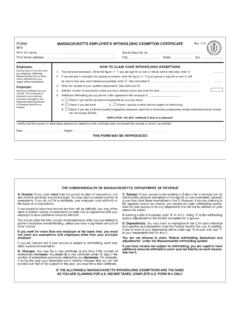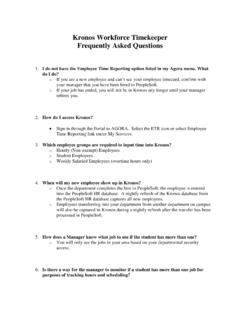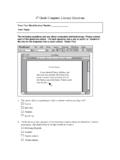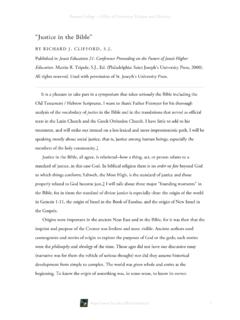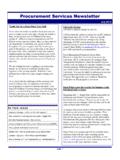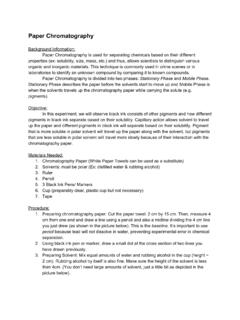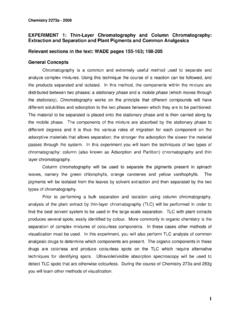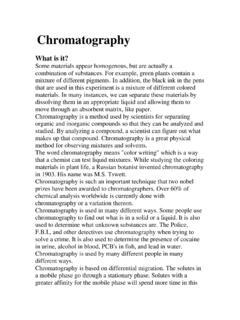Transcription of Thin Layer Chromatography (TLC) - Boston College
1 1 Experiment 4: Thin Layer Chromatography (TLC) In LTOC, read the introduction to Part 4, Chromatography , on pp 253-254, then read pp 255-269, Chapter 18. View video Thin- Layer Chromatography at Thin Layer Chromatography (TLC) is an easy, convenient and inexpensive way to determine how many components are in a mixture and, in many instances, can be used to identify the components as well. In today s experiments, you will gain experience with both paper and thin Layer Chromatography , you will work with a variety of developing solvents, and you will use several different techniques to visualize the spots of a chromatogram.
2 Paper Chromatography , which will be used to separate amino acids, is a form of partition Chromatography (see LTOC page 253). Water, a component of the developing solvent, forms hydrogen bonds with the fibers of the paper and serves as the stationary phase. The organic liquids that are also present in the developing solvent serve as the mobile phase. The components of the mixture are drawn up the paper to different heights, depending on their solubility in the mobile phase. The compounds that are more soluble in the organic liquid remain dissolved in the mobile phase longer than those that are less soluble and thus travel further up the paper.
3 Proteins, large molecules found in all living organisms, serve a variety of functions in metabolism, such as catalysis, transport, storage, control of growth and immune protection. Amino acids are the building blocks of proteins. Every amino acid has an amino group, a carboxyl group and a distinctive side-chain. Nature uses twenty different amino acids to synthesize proteins. The four amino acids that you will separate by paper Chromatography are alanine, leucine, lysine, and valine. Their structures are shown below.
4 H2 NCCHOHCH3OH2 NCCHOHH2 COCHCH3CH3H2 NCCHOH(H2C)4 ONH2H2 NCCHOHHCOCH3H3 CAlanineLeucineLy sineValine2 Amino acids are colorless compounds. In order to see the spots on the chromatogram, you will apply a solution of ninhydrin to the paper. Ninhydrin will react with the amino acid to produce a purple compound. Silica gel will serve as the stationary phase in the thin Layer Chromatography procedures. Finding a solvent or mixture of solvents that serves as an effective mobile phase is the most difficult part of TLC.
5 Often several different combinations of solvents are tested before one is found that will separate the compounds of interest successfully. You will observe the effect that different solvent systems have on the separation of the pigments in food dyes. You will also use TLC to identify the active ingredient in an over-the-counter medicine tablet. The tablet you will test contains one of the following: acetylsalicylic acid (aspirin), acetaminophen (the active ingredient in Tylenol), caffeine, or diphenhydramine hydrochloride (the active ingredient in Benadryl).
6 The structures of these four drugs are shown on the top of the next page. Like the amino acids, the medicine tablet ingredients will not be visible after the plate has been developed. The spots will be illuminated when viewed under short-wave ultraviolet light. Some of the spots will also change color when exposed to iodine vapors. OOOHOH+OCCHROHNH2 OOO ON+ RCHO + CO2 + H3O+ + 2H2O(purpl e)ni nhydrinamino acid3 Procedures Separating amino acids using paper Chromatography Work with a partner. Obtain a sheet of 13 x cm Whatman no.
7 1 Chromatography paper. When you handle this paper, hold it only on one of the long ( cm) sides, which will be considered the top of the sheet. The amino acids from your fingers will contaminate the paper and lead to erroneous results if it is touched on the bottom . Lay the sheet of Chromatography paper on a piece of notebook paper, and draw a line in pencil, not pen, cm above the bottom. Make small marks along the line using the dimensions given in Figure 1 on the Figs. 1, Expt. 4 page (you may bring the figure pages to lab).
8 Write labels at the top as shown in the figure. Use the small capillary tubes provided to make four spots, one of each amino acid (alanine, leucine, lysine and valine), along the pencil line. Follow the labels written at the top of the sheet. Your TA will assign each of you an unknown sample that contains one or more of these four amino acids. Spot this solution on the paper as well. For every spot you make, touch the capillary to the surface of the paper quickly and lightly so that the spot is approximately 2-3 mm in diameter.
9 Allow the spot to dry, then re-apply the solution at the exact same place, again touching the paper quickly and lightly. Allow the spot to dry, and repeat one more time. After all six solutions have been applied to the paper in this manner, allow the spots to dry for five minutes. Working together, roll the paper into a cylinder with the spots on the outside, then staple it so that the edges do not overlap or touch. See Figure 2 on the Figs. 1, Expt. 4 page. COOHOCOCH3 HONHCCH3 ONNNNOH3 COCH3CH3 Acetylsalicylic a cidAcetaminophenCaffeineDiphenhydramine h ydrochlorideONHCl4 Pour 50 mL of the amino acid developing solution into a 1000 mL beaker.
10 The developing solvent is comprised of a four-to-one mixture of 1-butanol and glacial acetic acid that has been saturated with water. Position the cylinder inside the beaker with the bottom edge immersed in the solvent. Make sure the paper does not touch the glass. Place a piece of aluminum foil over the mouth of the beaker. Allow the chromatogram to develop undisturbed for 60 to 75 minutes. Do not move the beaker while the chromatogram is developing! When you remove the paper from the beaker, mark the solvent front with a pencil.
